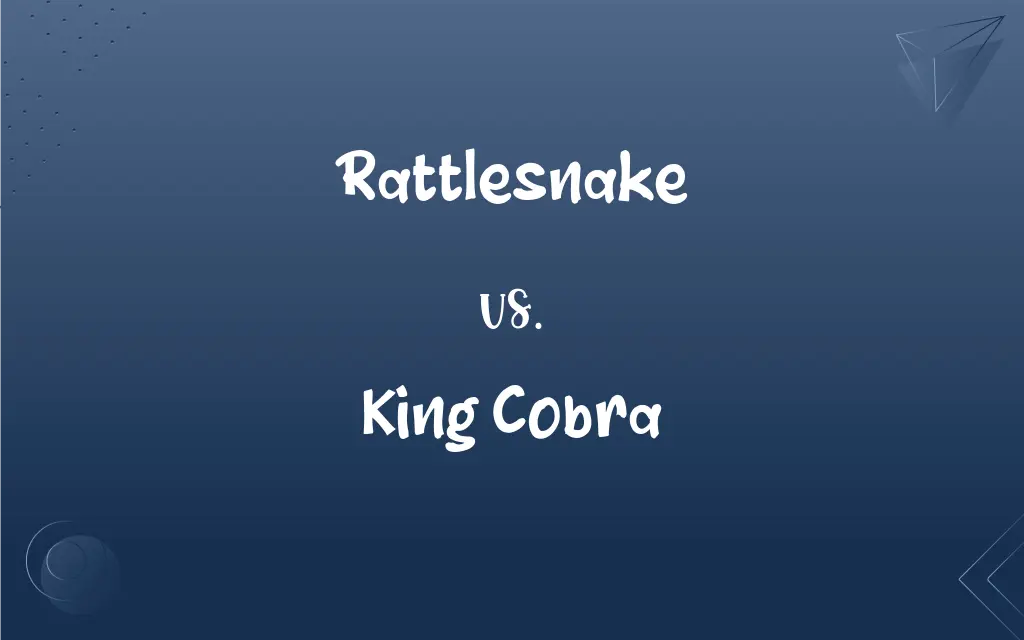Rattlesnake vs. King Cobra: What's the Difference?
Edited by Aimie Carlson || By Janet White || Published on February 22, 2024
Rattlesnakes are venomous snakes known for their distinctive tail rattle, while king cobras are the world's longest venomous snakes, recognized for their hood and ability to "stand."

Key Differences
Rattlesnakes belong to the pit viper family, primarily found in the Americas, and are known for their adaptability to various environments. King cobras, native to South and Southeast Asia, are the largest venomous snakes and prefer forested areas.
Rattlesnakes are notable for their rattling tails, used as a warning signal. King cobras, on the other hand, are distinguished by their hoods, which they expand when threatened, and their ability to raise a significant portion of their body off the ground.
Rattlesnake venom is hemotoxic, causing tissue damage and disrupting blood clotting. In contrast, king cobra venom is primarily neurotoxic, affecting the nervous system and leading to paralysis or even death if untreated.
Rattlesnakes are known for their ambush hunting tactics, primarily feeding on rodents and small animals. King cobras are unique among snakes for primarily preying on other snakes, including other venomous species.
Both species face threats from habitat loss and human conflict. Rattlesnakes are often featured in the folklore and symbolism of the Americas, while the king cobra holds a significant place in South and Southeast Asian culture.
ADVERTISEMENT
Comparison Chart
Habitat
Americas, various environments
South and Southeast Asia, forested areas
Distinctive Trait
Rattling tail
Hood and "standing" posture
Venom Type
Hemotoxic (affects blood and tissues)
Neurotoxic (affects nervous system)
Diet
Rodents, small animals
Other snakes, including venomous species
Cultural Significance
Symbolism in Americas
Revered in South and Southeast Asian culture
ADVERTISEMENT
Rattlesnake and King Cobra Definitions
Rattlesnake
Plays a significant role in the ecosystems of the Americas.
Rattlesnakes help control rodent populations in their habitats.
King Cobra
The world's longest venomous snake, recognizable by its hood.
The king cobra can be identified by its large size and unique hood.
Rattlesnake
A venomous snake known for its distinctive tail rattle.
Hiking in the desert, we heard the warning rattle of a rattlesnake.
King Cobra
Native to South and Southeast Asia, often found in forests.
King cobras are a majestic sight in the forests of Southeast Asia.
Rattlesnake
Possesses hemotoxic venom, causing tissue damage.
A rattlesnake bite can be extremely dangerous due to its hemotoxic venom.
King Cobra
Features neurotoxic venom, affecting the victim's nervous system.
The venom of a king cobra is potent enough to kill an elephant.
Rattlesnake
Belongs to the pit viper family, found in various American habitats.
Rattlesnakes are common in both desert and forested areas of the Americas.
King Cobra
Predominantly feeds on other snakes, including venomous species.
The king cobra's diet mainly consists of other snakes, showcasing its dominance in the wild.
Rattlesnake
Uses a rattling sound to warn predators and humans.
The rattlesnake's rattle is a clear sign to back away.
King Cobra
Revered in many Asian cultures and featured in folklore.
In some Asian cultures, the king cobra is seen as a symbol of power and mystery.
Rattlesnake
Any of various venomous pit vipers of the genera Crotalus and Sistrurus of the Americas, having at the end of the tail a series of loosely attached, horny segments that can be vibrated to produce a rattling or buzzing sound.
Rattlesnake
Any of various venomous American snakes, of genera Crotalus and Sistrurus, having a rattle at the end of its tail.
Rattlesnake
Any one of several species of venomous American snakes belonging to the genera Crotalus and Caudisona, or Sistrurus; sometimes also called rattler. They have a series of horny interlocking joints at the end of the tail which make a sharp rattling sound when shaken. The common rattlesnake of the Northern United States (Crotalus horridus), and the diamondback rattlesnake (also called diamondback rattler, and diamondback) of the South and East (Crotalus adamanteus) and West (Crotalus atrox), are the best known. See Illust. of Fang.
Rattlesnake
Pit viper with horny segments at the end of the tail that rattle when shaken
FAQs
How long can king cobras grow?
King cobras can grow up to 18 feet in length.
What kind of venom does a rattlesnake have?
Rattlesnakes have hemotoxic venom.
Can king cobras "stand"?
Yes, king cobras can raise up to a third of their body off the ground.
Are rattlesnakes protected in any regions?
Yes, some species of rattlesnakes are protected under conservation laws in various regions.
What regions are rattlesnakes native to?
Rattlesnakes are native to the Americas.
How does a rattlesnake's rattle work?
The rattle is made of interlocking segments that create sound when vibrated.
Are king cobras aggressive towards humans?
King cobras generally avoid humans but can be aggressive if threatened.
Can king cobras swim?
Yes, king cobras are proficient swimmers.
Is the king cobra the most venomous snake?
Not necessarily; while its venom is extremely potent, there are snakes with more toxic venom.
Are rattlesnake bites fatal to humans?
While potentially dangerous, most rattlesnake bites are not fatal if treated promptly.
How do rattlesnakes hunt?
Rattlesnakes typically use ambush tactics to capture prey.
How do king cobras care for their eggs?
King cobras are unique among snakes in that they build nests and guard their eggs.
What is the lifespan of a rattlesnake?
Rattlesnakes can live for 20 to 30 years.
What's the significance of the king cobra in Asian culture?
The king cobra is often revered and associated with power and wisdom in Asian cultures.
What's the primary diet of king cobras?
King cobras mainly eat other snakes.
What should you do if you encounter a king cobra in the wild?
Keep a safe distance, avoid sudden movements, and slowly back away from the snake.
Do rattlesnakes live in groups?
Rattlesnakes are generally solitary, except during mating season.
How do you identify a rattlesnake?
By its distinctive rattle at the end of its tail and its triangular-shaped head.
What habitat does the king cobra prefer?
King cobras prefer forested areas, often near water sources.
Is antivenom available for rattlesnake bites?
Yes, antivenom is available and effective for treating rattlesnake bites.
About Author
Written by
Janet WhiteJanet White has been an esteemed writer and blogger for Difference Wiki. Holding a Master's degree in Science and Medical Journalism from the prestigious Boston University, she has consistently demonstrated her expertise and passion for her field. When she's not immersed in her work, Janet relishes her time exercising, delving into a good book, and cherishing moments with friends and family.
Edited by
Aimie CarlsonAimie Carlson, holding a master's degree in English literature, is a fervent English language enthusiast. She lends her writing talents to Difference Wiki, a prominent website that specializes in comparisons, offering readers insightful analyses that both captivate and inform.
































































